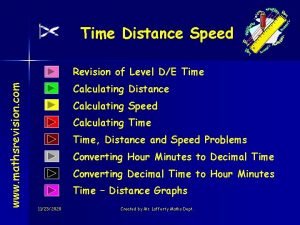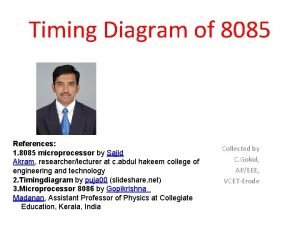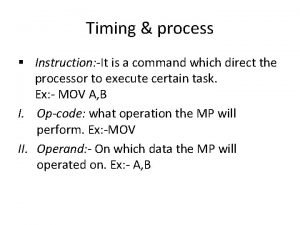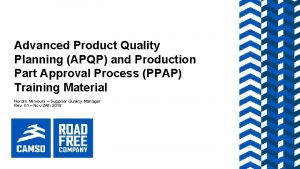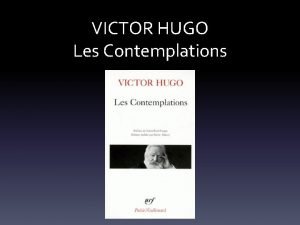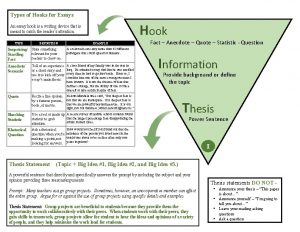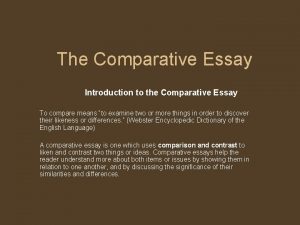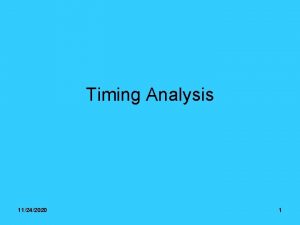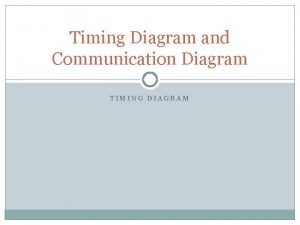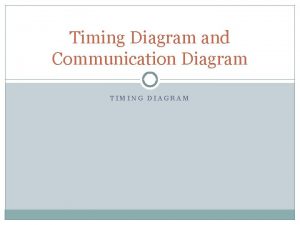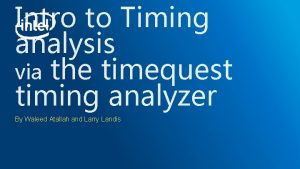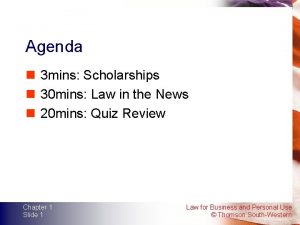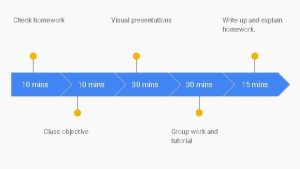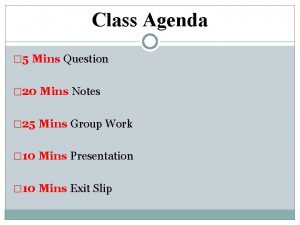Timing plan 5 mins Write 15 mins Intro












- Slides: 12

Timing – plan 5 mins Write 15 mins Intro – link to the question. Explain where the extract happens in the play Start of the extract – choose 2 – 3 quotes to explore Middle of the extract – choose 2 – 3 quotes to explore End of the extract – choose 2 – 3 quotes to explore Conclude – Short summary of points Romeo & Juliet Extract Answer Place your extract here Exploring the quotes: Link to the question Link to the terminology Link to quote(s) Explore the hidden and obvious meaning Zoom in on the words Explore the effect What were the writers’ intentions Remember – you don’t have to do every step every time Terminology: soliloquy; individual speech by the character, dramatic irony; audience is more aware than the characters, repetition; ideas/words phrases repeated, metaphor; comparison of something as something else, hyperbole; use of exaggeration for effect, imagery; creating a picture in the mind of the reader, simile; comparison using like or as, dialogue; the speech of characters (think, length, tone, pace)…

Timing – plan 5 mins. Write 35 mins. Intro – link to the question. Explain which 3 events in the play you will focus on Idea 1 choose a moment from the play to explore (quotes if remembered) Idea 2 choose a 2 nd moment from the play to explore (quotes if remembered) Idea 3 choose a moment from the play to explore (quotes if remembered Conclude – Short summary of points Romeo & Juliet Essay Answer Plan your essay here; Intro Link to question: Link to 3 ideas: Idea 1 Moment/quotes: Language/struct link: Idea 2 Moment/quotes: Language/struct link: Idea 3 Moment/quotes Language/struct link Conclude Summary of points: Think Key Questions linked to the question: How is ____ shown at the start/middle/end? What type/effect does this have_____? How is this shown? What supports this from the play? Exploring the quotes: Link to the question Link to the terminology Link to quote(s) or the moment – paraphrase what happens in this section of the play Explore the hidden and obvious meaning Zoom in on the words Explore the effect What were the writers’ intentions Terminology: soliloquy; individual speech by the character, dramatic irony; audience is more aware than the characters, repetition; ideas/words phrases repeated, metaphor; comparison of something as something else, hyperbole; use of exaggeration for effect, imagery; creating a picture in the mind of the reader, simile; comparison using like or as, dialogue; the speech of characters (think, length, tone, pace)…

Timing – plan 5 min. and write 40 minutes Intro – link to question. Explain where the extract happens. Give a brief overview of text. Start of the extract – choose 2 – 3 quotes to explore – Explode this and link to wider text. Middle of the extract – choose 2 – 3 quotes to explore. Explode this and link to wider text. End of the extract – choose 2 – 3 quotes to explore. Explode this and link to the wider text. Conclude – Short summary of points Explode the Extract Answer; BB, AIC, LOTF Sentence starters: In the extract… this suggests/implies/infers/conveys… The whole text shows… Linking this… Place your extract here Plan and decide how to explode to the whole text as you plan each section Exploring the quotes: Link to the question Link to the terminology Link to quote(s) Explore the hidden and obvious meaning Zoom in on the words/connotations Explore the effect What were the writers’ intentions Link to the text – Explain which moment you are linking to – quote if remembered – analyse and link back to the extract Remember – you don’t have to do every step every time Terminology: dramatic irony; audience is more aware than the characters, repetition; ideas/words phrases repeated, metaphor; comparison of something as something else, hyperbole; use of exaggeration for effect, imagery; creating a picture in the mind of the reader, simile; comparison using like or as, tone – the impression you are given of how the words sound, emotive language; appeals to reader emotions, personification; makes an object sound human etc.

Timing – plan 5 min. and write 40 minutes Intro – link to question. Explain where the extract happens. Give a brief overview of text. Can say time period/influences (context) Start of the extract – choose 2 – 3 quotes to explore – Explode this and link to wider text. Link to context here. Middle of the extract – choose 2 – 3 quotes to explore. Explode this and link to wider text. Link to context here. End of the extract – choose 2 – 3 quotes to explore. Explode this and link to the wider text. Link to context here. Conclude – Short summary of points Explode the Extract Answer; A Christmas Carol with Context Sentence starters: In the extract… this suggests/implies/infers/conveys… The whole text shows… Linking this… Contextually… Historically… In Victorian Times… Place your extract here Plan and decide how to explode to the whole text as you plan each section. Also, make a short note of how the context links to your analysis too. Exploring the quotes: Link to the question Link to the terminology Link to quote(s) Explore the hidden and obvious meaning Zoom in on the words/connotations Explore the effect What were the writers’ intentions Link to the text – Explain which moment you are linking to – quote if remembered – analyse and link back to the extract Link to context – Explain what it was like at the time. Embed it with your analysis. Explore links to analysis Terminology: description; use of extended pieces of detail to emphasise conditions and characters , repetition; ideas/words phrases repeated, metaphor; comparison of something as something else, hyperbole; use of exaggeration for effect, imagery; creating a picture in the mind of the reader, simile; comparison using like or as, tone – the impression you are given of how the words sound, emotive language; appeals to reader emotions, personification; makes an object sound human, Use of complex sentences; to explore in detail emotions; pathetic fallacy; sets the tone/mood/atmosphere. Etc.

Timing – plan 5 min. write 15 mins. Intro – link to question. Explain where meaning of the poem briefly. Can say time period/influences (context) Throughout the poem – Choose relevant quotes and analyse the language, structure and effect of these quotes. Refer to the question and explain the meaning. Also, link to the context too. Conclude – Short summary of points Anthology; single poem essay Sentence starters: In the poem we see… this suggests/implies/infers/conveys… The poet implies/shows… Linking this to the time/place/intentions Place your poem here Plan and decide which quotes to select and which 3 pieces of context you will write about Exploring the quotes: Link to the question Link to the terminology Link to quote(s) Explore the hidden and obvious meaning Zoom in on the words/connotations Explore the effect What were the writers’ intentions Link to context – Explain what it was like at the time. Embed it with your analysis. Explore links to analysis Terminology: repetition; ideas/words phrases repeated, metaphor; comparison of something as something else, hyperbole; use of exaggeration for effect, imagery; creating a picture in the mind of the reader, simile; comparison using like or as, tone – the impression you are given of how the words sound, emotive language; appeals to reader emotions, personification; makes an object sound human, Use of complex sentences; to explore in detail emotions; pathetic fallacy; sets the tone/mood/atmosphere. End-stopping; punctuation at the end of line, caesura; punctuation in the middle of a line; enjambment; run on lines in the poem; stanza’s; the verses of the poem; layout; how it appears and what effect this has, connotations; implied meanings

Timing – plan 5 min. write 35 mins. Intro – link to question. Explain where meaning of the poem briefly. Can say time period/influences (context) Throughout the essay– Start with the 2 nd poem, choose relevant quotes/moments from the poem and analyse the language, structure and effect of these quotes and how they link to examples and analysis from poem 1. You must use connectives of comparison. Refer to the question and explain the meaning. Also, link to the context too for both poems Conclude – Short summary of points Anthology; comparison poem essay Sentence starters: In the poem we see… this suggests/implies/infers/conveys… The poet implies/shows… Linking this to the time/place/intentions Place your poem here Plan and decide which quotes to select and which 3 pieces of context you will write about Exploring the quotes: Link to the question Link to the terminology Link to quote(s) Explore the hidden and obvious meaning Zoom in on the words/connotations Explore the effect What were the writers’ intentions Use connectives of comparison to show you are aware of the similarities and differences in the poems. Link to context – Explain what it was like at the time. Embed it with your analysis. Explore links to analysis Terminology: repetition; ideas/words phrases repeated, metaphor; comparison of something as something else, hyperbole; use of exaggeration for effect, imagery; creating a picture in the mind of the reader, simile; comparison using like or as, tone – the impression you are given of how the words sound, emotive language; appeals to reader emotions, personification; makes an object sound human, Use of complex sentences; to explore in detail emotions; pathetic fallacy; sets the tone/mood/atmosphere. End-stopping; punctuation at the end of line, caesura; punctuation in the middle of a line; enjambment; run on lines in the poem; stanza’s; the verses of the poem; layout; how it appears and what effect this has, connotations; implied meanings

Timing – plan 5 min. write 15 mins. Intro – link to question. Explain what the meaning of the poem is briefly. Throughout the poem – Choose relevant quotes (6 or more) and analyse the language, structure and effect of these quotes. Refer to the question and explain the meaning. The examiner wants to know you can make an educated guess, so just give it a go. Conclude – Short summary of points Unseen Poetry; single poem essay Sentence starters: In the poem we see… this suggests/implies/infers/conveys… The poet implies/shows… Linking this to the time/place/intentions Place your poem here Plan and decide which quotes to select and which 3 pieces of context you will write about Exploring the quotes: Link to the question Link to the terminology Link to quote(s) Explore the hidden and obvious meaning Zoom in on the words/connotations Explore the effect What were the writers’ intentions Don’t get stuck on meaning – read and reread the poem. Look for clues in the question to help you. Terminology: repetition; ideas/words phrases repeated, metaphor; comparison of something as something else, hyperbole; use of exaggeration for effect, imagery; creating a picture in the mind of the reader, simile; comparison using like or as, tone – the impression you are given of how the words sound, emotive language; appeals to reader emotions, personification; makes an object sound human, Use of complex sentences; to explore in detail emotions; pathetic fallacy; sets the tone/mood/atmosphere. End-stopping; punctuation at the end of line, caesura; punctuation in the middle of a line; enjambment; run on lines in the poem; stanza’s; the verses of the poem; layout; how it appears and what effect this has, connotations; implied meanings

Timing – plan 5 min. write 35 mins. Intro – link to question. Explain where meaning of the poem briefly. Can say time period/influences (context) Throughout the essay– Start with the 2 nd poem, choose relevant quotes/moments from the poem and analyse the language, structure and effect of these quotes and how they link to examples and analysis from poem 1. You must use connectives of comparison. Refer to the question and explain the meaning. Conclude – Short summary of points Unseen; comparison poem essay Sentence starters: In both poems we see… this suggests/implies/infers/conveys… The poet implies/shows… Linking this to the time/place/intentions … In both we see… Similarities and differences are shown… Place your poem here Plan and decide which quotes to select and which 3 pieces of context you will write about Exploring the quotes: Link to the question Link to the terminology Link to quote(s) Explore the hidden and obvious meaning Zoom in on the words/connotations Explore the effect What were the writers’ intentions Use connectives of comparison to show you are aware of the similarities and differences in the poems. Terminology: repetition; ideas/words phrases repeated, metaphor; comparison of something as something else, hyperbole; use of exaggeration for effect, imagery; creating a picture in the mind of the reader, simile; comparison using like or as, tone – the impression you are given of how the words sound, emotive language; appeals to reader emotions, personification; makes an object sound human, Use of complex sentences; to explore in detail emotions; pathetic fallacy; sets the tone/mood/atmosphere. End-stopping; punctuation at the end of line, caesura; punctuation in the middle of a line; enjambment; run on lines in the poem; stanza’s; the verses of the poem; layout; how it appears and what effect this has, connotations; implied meanings

Timings: Reading – 10 A 1 – 5, A 2 – 8, A 3 – 12 A 4 – 12, A 5 – 12 minutes Language Reading Exam Key Reminders Fiction 1 A Reading A 1 – list 5 points linked to the question in separate bullet points A 2 – Language Analysis – link to question, quote, terminology, meaning & effect (7 – 8 quotes) A 3 - Language Analysis – link to question, quote, terminology, meaning & effect (7 – 8 quotes) A 4 – Language and Structure Analysis -link to question, quote, terminology, meaning & effect – levels of tension and drama too (7 -8 quotes) A 5 – Persuasive evaluation – Link to question, quote, opinion, alternative readers opinions(build argument) Terminology: emotive language, hyperbole, metaphor, simile, facts, personification, , imagery, tone, sentence structures, repetition first/second/third person, narrative TOP TIPS: Be Concise Use connectives to move onto your next point Choose short and snappy quotes Choose quotes that stand out Choose quotes that link to the question Timing is key Moving onto the next point Also… Another idea… As well as… Moreover… Furthermore … To support this… To enhance… In addition… Comparing (similarities) Compared with… Similarly… In the same way… Likewise… Equally… As with… …are similar in that… Word Class: Noun Adjective Verb Adverbs Connotations Contrasting (differences) However… On the other hand… On the contrary… Instead… As for… Alternatively … Despite this… …whereas… …while. . . …although… …yet… Timings: Reading – 14 A 1 – 5, A 2 – 12, A 3 – 5 A 4 – 12, A 5 – 12 minutes Non - Fiction 2 A Reading A 1 – list 3 points linked to the question in separate bullet points A 2 – Language Analysis – link to question, quote, terminology, meaning & effect (7 – 8 quotes) A 3 – Answer 2 or 3 questions where you select information or make inferences on the text A 4 – Persuasive evaluation – Link to question, quote, opinion, alternative readers opinions(build argument) A 5 – Synthesis question bring together information from two texts using quotes and showing similarities or differences *NOT COMPARING* (4 or more quotes) A 6 – Comparison question – compare similarities or differences in both texts (select a range of quotes from both texts)

Timings: Reading – 10 A 1 – 5, A 2 – 8, A 3 – 12 A 4 – 12, A 5 – 12 minutes Language Writing Exam Key Reminders Fiction 1 B Writing Choice of 4 task titles Write a story Structure it effectively – opening – rising action – climax – falling action – resolution Keep it interesting and engaging Make it believable Stick to something you know Don’t overcomplicate the plot Do use language to create imagery and tension if applicable • • Writing Success Criteria: You must plan your writing – this will aid clarity and stop you forgetting what you were going to add in TIPTOP paragraphs = time, place, topic, person – new paragraph Sentence structures – use a variety – simple, compound and complex Check your spelling Check your punctuation -. , ; : ! ? Make sure you have capital letters for the start of sentences and Proper Nouns Edit your writing – go back and check you have included all the words in sentences Techniques you can use are: emotive language, hyperbole, metaphor, simile, facts, personification, , imagery, tone, sentence structures, repetition, triplets first/second/third person, narrative voice, alliteration, dialogue (sparingly) Timings: 5 minutes planning 25 minutes writing then move onto the second task Non - Fiction 2 B Writing Transactional Writing: writing for a purpose You will have to write two separate texts Check the PAFT – Purpose, audience, format and tone – highlight the question to identify this first You may be asked to write to: Inform, advise, persuade, entertain, review You may be asked to format this as: Speech, letter, review, article or report Check your audience (who you are writing for) carefully and consider the tone you use. Tone – should it be Formal or Informal, friendly or serious, consider this carefully.

Romeo & Juliet – 1 hour Literature Paper 1: Reading Analysis Intro – link to the question. Explain where the extract happens in the play, Start of the extract – choose 2 – 3 quotes to explore, Middle of the extract – choose 2 – 3 quotes to explore, End of the extract – choose 2 – 3 quotes to explore, Conclude – Short summary of points Poetry Anthology – 1 hour Extract – 20 minutes – 15 marks Essay – 40 minutes – 25 marks Intro – link to the question. Explain which 3 events in the play you will focus on, Idea 1 choose a moment from the play to explore (quotes if remembered) Idea 2 - choose a 2 nd moment from the play to explore (quotes if remembered), Idea 3 - choose a moment from the play to explore (quotes if remembered, Conclude – Short summary of points Guide to analysis for both R&J and The Anthology Link to the question – explain briefly what you think Quote to support what you have said Explain fully the meaning – obvious and hidden meanings Link to the subject terminology (language or structure) Explore connotations of words or hidden meaning Explain the effect on the reader or the writers’ intentions Link to the question at some point in your answer Explore alternative meanings You will also have to link to context. Single poem 20 minutes – 15 marks Write an overview statement about what the poem is suggesting (remembering not to write it in the first person – think about it as a critical analysis task), Choose 6 or more quotes to analyse, Link closely to context, Conclusion – give a brief summary of what you think the poem is about and a link to the question again. Make sure you have covered a couple of quotes from the top, middle and bottom of the poem. Comparison poem - 40 minutes– 25 marks Write an overview statement about what both the poems are suggesting, Start with poem 2 you will need to remember quotes for this analyse and compare this to poem 1, Link closely to context for both poems, Conclusion – give a brief summary of what you think both poems have in common are how they are different and link to the question again. Comparing (similarities) Compared with… Similarly… In the same way… Likewise… Equally… As with… …are similar in that… Contrasting (differences) However… On the other hand… On the contrary… Instead… As for… Alternatively… Despite this… …whereas… …while. . . …although… …yet…

Blood Brothers/An Inspector Calls/Lord of the Flies – 45 minutes Explode the extract (35 marks and 5 SPAG & VOCAB marks) Introduction: Explain the whole text briefly and give an overview of meaning in the extract linked to the question. State where in the text the extract is from. Main Section of the Essay – (Note not a paragraph, but a section of the essay); Address the start of the extract and use quotes to explore what it means and how it is linked to the question. Focus closely on language and structure here and explore carefully specific words and their meanings (I like you to use connotations for this). Now, bring in the whole text. Is there an example/moment/quote from somewhere else in the text that you can write about which supports or shows development of the idea you have included in this section of the essay? (Also, you can interlink examples from different places in the text) Focus on the middle of the extract and repeat the analysis linked to the question for the extract and again bring in the whole text. Repeat the analysis of key quotes/moments in the extract and moments in the book until you have covered up to 6 quotes from the extract and engaged with 3 other areas from the whole text. Conclusion Summarise what you think about the question linking it first to the extract and then to the whole text as well. A Christmas Carol – 45 minutes Explode the extract and include context Do exactly the same structure as the Blood Brothers/An Inspector Calls/Lord of the Flies Essay, but when you link to the whole text or when you move on from the analysis of the extract – Link to context at these points. Guide to analysis: BB/AIC/LOTF, A Christmas Carol & The Unseen Poetry Link to the question, Quote, Explain meaning – obvious and hidden, Link to the subject terminology (language or structure), Explore connotations of words, Explain the effect on the reader or the writers’ intentions, Link to the question, Explore alternative meaning (A Christmas Carol Link To Context) Literature Paper 2: Reading Analysis Unseen Poetry – 1 hour Single poem 20 minutes – 15 marks Write an overview statement about what the poem is suggesting (remembering not to write it in the first person – think about it as a critical analysis task), Choose 6 or more quotes to analyse, Conclusion – give a brief summary of what you think the poem is about and a link to the question again. Make sure you have covered a couple of quotes from the top, middle and bottom of the poem. Comparison poem - 40 minutes– 25 marks Write an overview statement about what both the poems are suggesting, Start with poem 2 analyse and compare this to poem 1, state the similarities and differences and use comparison connectives, Conclusion – give a brief summary of what you think both poems have in common are how they are different and link to the question again. See Paper One Guide for useful connectives
 Speed tdst
Speed tdst 1° to minutes
1° to minutes 65 mins
65 mins Timing diagram of i/o write cycle in 8085
Timing diagram of i/o write cycle in 8085 Sta timing diagram
Sta timing diagram Timing diagram of sta 2050h
Timing diagram of sta 2050h Ppap meaning
Ppap meaning Cache memory mengacu pada konsep locality of reference
Cache memory mengacu pada konsep locality of reference Example of a thematic essay
Example of a thematic essay Victor hugo aurore
Victor hugo aurore Hook writing examples
Hook writing examples Quotation hook
Quotation hook How to write a comparative essay introduction
How to write a comparative essay introduction
